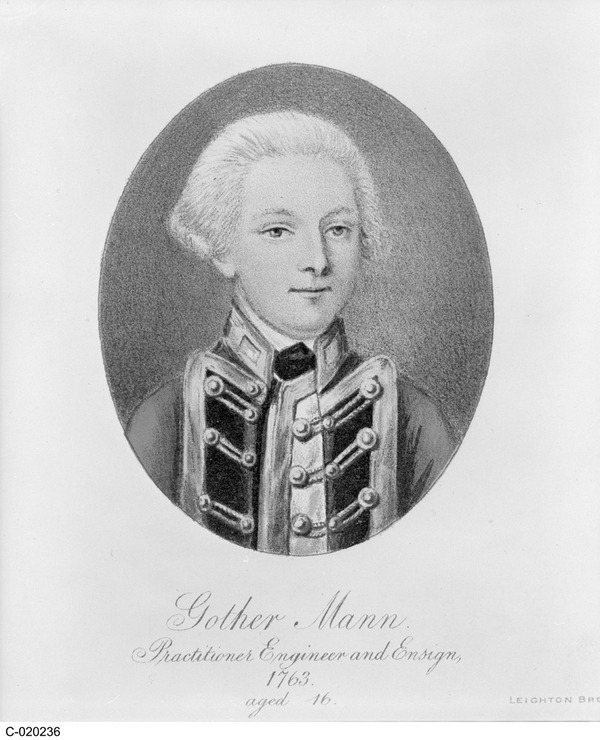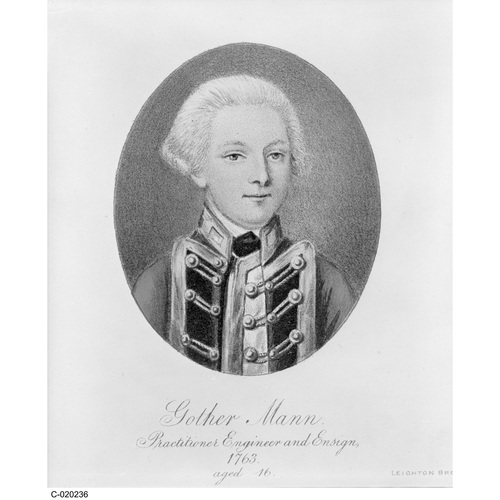
Source: Link
MANN, GOTHER, army officer and military engineer; b. 21 Dec. 1747 in Plumstead (London), England, second son of Cornelius Mann and Elizabeth Gother; m. 1767 Anne Wade, and they had eight children; d. 27 March 1830 in Lewisham (London), England.
Graduating from the Royal Military Academy at Woolwich (London) in 1763, Ensign Gother Mann was employed for the next 12 years on defence installations along the English coast. Commissioned lieutenant in 1771, he was posted to Dominica in the West Indies late in 1775 and while there was promoted captain in 1777. From 1779 to 1785 he served in Great Britain, reporting on defence arrangements on the east coast of England in 1781 at the request of Jeffery Amherst*, commander-in-chief of the British forces.
In 1785 Mann, then 38, was sent to the province of Quebec as captain and commanding engineer. As were his predecessor, William Twiss, and his successor, Ralph Henry Bruyeres*, who had accompanied him to Quebec, Mann was preoccupied with five principal items: the canals on the St Lawrence, the fortifications at Quebec, the defence of the routes into the province through the St Lawrence valley and the Richelieu valley, the possibility of war with the United States, and the more prosaic day-to-day duties of the engineers. In 1788 the governor, Lord Dorchester [Guy Carleton*], instructed Mann to conduct an extensive examination of military posts from Kingston (Ont.) to St Mary’s (Sault Ste Marie, Ont.). The result was a detailed and useful 34-page appraisal of the posts, harbours, and navigable water routes. Although the report bears the signature of John Collins*, deputy surveyor general of Quebec, it is recognized as being the work of the commanding engineer. Mann delineated the decay that had set in since the conclusion of the American revolution, complaining of posts “improperly placed” and faultily constructed. He riddled his report with phrases such as “moulded away,” “fallen down,” “entirely rotten,” and “all in ruins.” Most of the bases he was instructed to inspect were actually on the American side of the border established by the Treaty of Paris (1783); the British continued to occupy the western posts until two years after the signing of Jay’s Treaty in 1794.
Mann spent 1792–93 in the Netherlands, participating in various sieges of French forces. Promoted lieutenant-colonel late in 1793, he was ordered to return to Lower Canada to prepare defences at Quebec, since war with the United States seemed a possibility. Four years later he became a colonel. In 1800 he prepared a report on the state of the St Lawrence canals in which he referred to the locks as “very defective” and “much decayed.” Understanding the vital importance of the canals in facilitating commercial and military movements, he suggested repairs and alterations, the latter necessitated by the larger craft involved and the decrease in water level since the construction of the locks had begun in 1779. At the turn of the century, British officials were also concerned with the possible impact of a proposed American canal from Lake Ontario to Albany, N.Y. The colonial secretary, Lord Hobart, suggested to Lieutenant-General Peter Hunter*, commander of the forces in the Canadas, that he select someone to look into the matter. Mann, whom Hobart described as “an officer of so much merit and experience . . . from whose professional abilities you will no doubt derive every possible assistance,” was chosen. In 1803 Mann was promoted major-general and obtained permission to return to England where his family had remained. He left British North America in the spring of 1804.
During his two tours in the Canadas, Mann penned several reports on the necessity of a proper and permanent system of defence at Quebec. “When it is considered how greatly the safety and preservation of this part of His Majesty’s Dominions depend on Quebec . . . too much attention cannot be paid to promote its strength and security.” Although he recognized that a Canadian winter would offer a formidable obstacle to even a “strong, active and enterprising enemy,” more defence than that was required for a military post “of consequence” such as Quebec, the “only hopefull resource in case of Invasion.” Mann’s recommendations for this defence system – the completion of the wall encircling the town, the construction of auxiliary defence works in front of the wall, the occupation of the Plains of Abraham, and the construction of a citadel at Cap Diamant – were not all carried out during his tenure, but would form the basis of any military construction at Quebec during the first half of the 19th century.
From August 1801 until his departure in 1804 Mann had been the second most senior officer in the Canadas. With strong support from Hunter, who left him in command of Lower Canada for periods of several months, he successfully petitioned for the salary of a brigadier because of his additional duties. He informed Hunter that the sum would make him “very comfortable.”
After his return to Britain, Mann assumed various responsibilities as colonel commandant of the Royal Engineers, a commission he received in 1805. He obtained promotions: lieutenant-general in 1810 and inspector general of fortifications the following year. In these posts he continued his involvement with Canadian defences and communications, commenting on the construction of the citadel at Quebec and the attempt made by the Royal Engineers in the latter half of the 1820s to locate a navigable water route between Penetanguishene, Upper Canada, and the Ottawa River via Lake Simcoe. He also appointed engineer John By* to superintend construction of the Rideau Canal. In 1821 Mann was made a general and he was the senior officer in the engineers when he died at age 82.
PAC, MG 23, J10; MG 25, G235; RG 8, I (C ser.), 30, 38–39, 54, 61, 381–84, RG 8, 11, 8–10. Gentleman’s Magazine, January–June 1830: 477. DNB. “Papiers d’État,” PAC Rapport, 1890: 301–3, 322. “Papiers d’État – Bas-Canada,” PAC Rapport, 1891: 74, 152. André Charbonneau et al., Quebec ville fortifiée, du XVIIe au XIXe siècle (Québec, 1982). Whitworth Porter et al., History of the Corps of Royal Engineers (9v. to date, London and Chatham, Eng., 1899– ; repr. vols.1–3, Chatham, 1951–54), 1.
Cite This Article
John C. Kendall, “MANN, GOTHER,” in Dictionary of Canadian Biography, vol. 6, University of Toronto/Université Laval, 2003–, accessed December 12, 2025, https://www.biographi.ca/en/bio/mann_gother_6E.html.
The citation above shows the format for footnotes and endnotes according to the Chicago manual of style (16th edition). Information to be used in other citation formats:
| Permalink: | https://www.biographi.ca/en/bio/mann_gother_6E.html |
| Author of Article: | John C. Kendall |
| Title of Article: | MANN, GOTHER |
| Publication Name: | Dictionary of Canadian Biography, vol. 6 |
| Publisher: | University of Toronto/Université Laval |
| Year of publication: | 1987 |
| Year of revision: | 1987 |
| Access Date: | December 12, 2025 |



